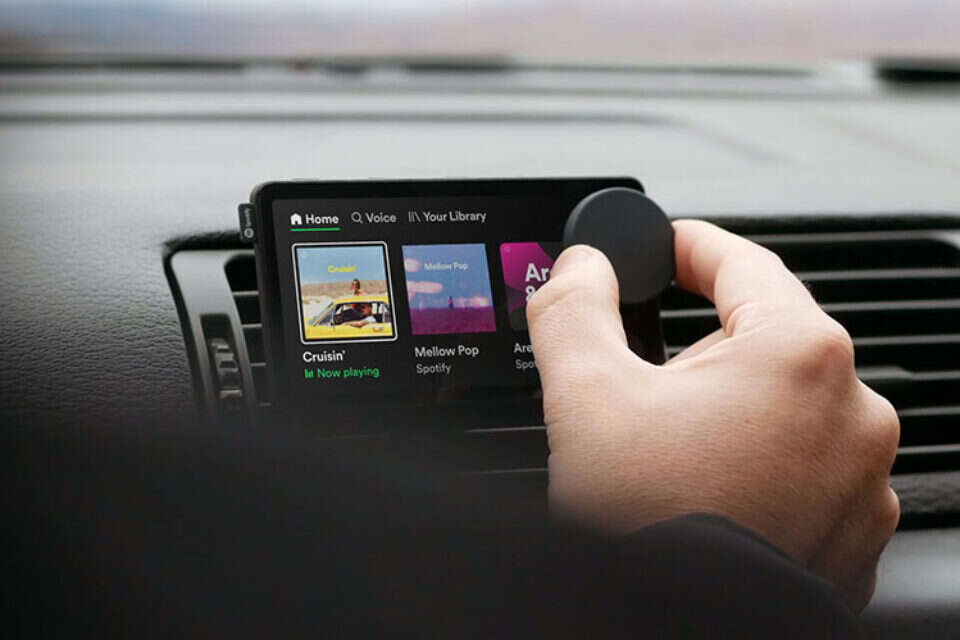The Car Thing is Spotify's first hardware product, and was built specifically to provide a solution for people with old vehicles.
A few weeks ago, I was given a first chance to try the new product, which is currently only available to a few testers in the US, here in Israel. After two weeks of playing around, I realized how Car Thing can easily become an integral part of many people's systems. On the other hand, with a long waiting list and uncertainty about a global launch, I believe many would already prefer to use other solutions.
From idea to reality
Somewhere in 2018, Spotify users began to receive an interesting offer in their email inbox - the option to purchase a new device with voice control and fourth-generation connectivity that would make any old car system smart. Rumors slowly faded until a year later, when the Financial Times website revealed that the company plans to soon introduce a new car product that simulates a smart radio with Bluetooth connectivity. A few months later, those rumors made headlines again after the music service was updated with the state of the vehicle - the same one we know today from the app - which is activated as soon as the smartphone detects a connection to the system in the car.
Two years have passed since then.
After countless rumors and leaks, Spotify last April unveiled "Car Thing", its smart vehicle system.
Spotify has chosen to release the new device in a very limited way, with a long waiting list and many delays when it comes to shipments.
So of course, right after the press conference that took place, I went to the site and signed up.
Two months later, the long-awaited message arrived.
Reconnecting to the site will give me the option to purchase the device with a little surprise - it will not cost me anything.
After another month of waiting, the courier finally knocked on my door, accompanied by a small box with the Spotify logo on it.
Spotify's Car Thing, Photo: Amit Lego
The
Car Thing
First and foremost, the Spotify device impressed me greatly with the quality of its construction. It is slightly smaller than my iPhone 11 and includes a large, bright and sharp touch screen on the front. You will also find a round button and dial next to the screen that you can rotate to navigate between the interface screens. And despite the huge dial, which you can see in the photos, the Car Thing manages to maintain a relatively thin profile and not stand out too much from the dashboard. Personally, I would prefer that the company allow me to change the dial activity so that I can control the volume of the smartphone, since I can also navigate using the touch screen. This may be possible in a future version update.
The device comes in a small and minimalist cardboard box, which includes a USB Type C cable and various adapters for its installation.
Many of you probably remember how in the past we used to unplug radios and hide them in a drawer after getting out of the car.
The Car Thing undoubtedly brings back that feeling with its construction form.
All the adapters connected to the body of the device using a magnet that was very strong, which prevented it from falling even when driving on dirt roads.
In addition, small buttons can be found along the entire top, which can be easily set to play various playlists or podcasts.
By long pressing one of the buttons while listening, or by requesting the voice assistant, I set up some playlists that I hear frequently and the radio show I listen to every morning on the go.
In doing so, the feature made me feel that Car Thing is more like a car radio than an extension of my smartphone.
From an old car to a smart car
After a fairly simple physical installation, I plugged the Car Thing into power.
I was pleasantly surprised by the definition process.
The instructions were clear, the connection to the Spotify app took less than 5 minutes, and a few moments later I got to the home screen.
In fact, the device connects to the smartphone via Bluetooth and controls the app like a remote control, so it can copy all the information about our account from it.
This means that you will still have to connect your smartphone to the car, either via Bluetooth or via the AUX cable in order to hear the music.
The home screen is familiar to all users of the app, as like the smartphone app, it emphasizes album art and playlists.
Also, on the home screen, like the one in the app, you will find recommendations for music according to your taste, your search screen and your personal library.
As mentioned, you can navigate between the various screens using the touch screen or using the manual caliper.
What’s more, you can call the device’s voice assistant at any given moment by saying “Hi Spotify”.
With it, you can play songs, playlists, albums and even search for podcasts.
From my experience she recognized my voice quite easily even when the music was playing in the background and the air conditioner was blowing directly on the device.
This is probably thanks to the four microphones installed at the top.
It is important to note that at the moment the voice assistant does not support Hebrew, and as of the time of publication of the article, there is no information on when such an update will arrive.
So is it worth the wait?
My experience of using the device has been great, which is a positive surprise to me given that it is still in the initial release phase. Even in intensive use on long trips, the device continued to work smoothly without disconnecting from my smartphone. Still, occasionally there is a slight stutter in the interface, but I believe Spotify will address such bugs with future version updates. It is evident that the Swedish company has worked on it a lot in recent years, and of the various versions that leaked online during this period, the design of the final product is probably my favorite.
Still, when I saw the Car Thing for the first time, I wondered who exactly the company was trying to target. After all, its activity comes down to controlling the app on a smartphone, and not much beyond that. What is it different from buying a car stand for a few shekels and connecting it so that the smartphone is closer to us while driving? This question is reinforced when you consider that iPhones and Android devices are much more powerful than Spotify, and most of the time will give the user much more functionality. Despite all this, as I used Car Thing more and more, I realized how it could improve the driving experience. The ability to see the Waze on my smartphone screen and control the music on a completely different screen, is one I have learned to appreciate in the last two weeks.
One question remains - will Spotify even launch the device to the general public?
And if so, will it be launched here in our small country as well?
Swedish society does not tell much at the moment.
It has not even shared how many testers the device is currently running around the world, and how many it plans to add in the limited launch in the United States.
The only thing we know for sure is the price, which is expected to be $ 79 (about NIS 255).
Meanwhile, the Car Thing provides an initial glimpse into the concept that Spotify has been trying to crack for years.
Spotify Israel stated that there is currently no information on a plan to launch the device in Israel










/cloudfront-eu-central-1.images.arcpublishing.com/prisa/KMEYMJKESBAZBE4MRBAM4TGHIQ.jpg)


